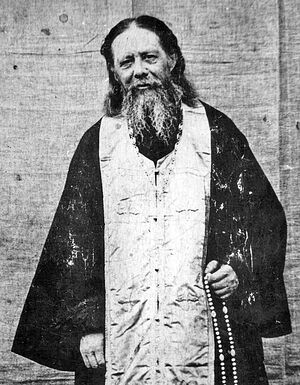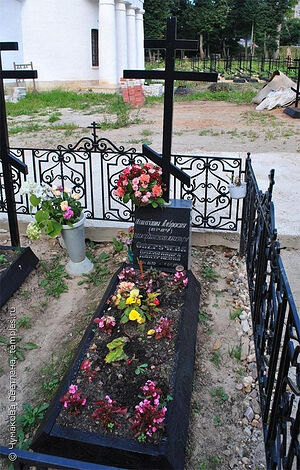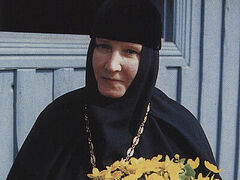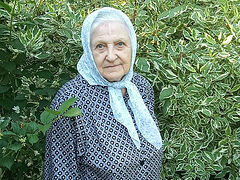Alexandra Dmitrievna worked at several different hospitals during her lifetime, but wherever she worked, icons were placed in the wards at her orders, and clergymen were invited to give Communion to patients. She always helped those who were in sorrow and in material need. If there were no beds available in the hospital, she took seriously ill people to her home and treated them until they fully recovered. Helping people brought her joy.
From the beginning of the First World War Alexandra Dmitrievna volunteered as an army nurse and went to the front line of the Western Front. The courageous doctor barely managed to get to the first dressing station, located near the place where a battle was going on.
“It was a terrible sight: wounded people were lying on the floor, which was soaked in blood; the skulls of many were seriously injured and the brain was visible; their faces were covered with sticky blood, annoying flies stuck to them. I wiped the eyes and the whole faces of the sufferers with a damp towel, and they thanked me with the tender look in their fading eyes,” she related.
She saw such horrible scenes in sick quarters and field hospitals during her three years at the front. An extremely sensitive person, she took the pain and suffering of the wounded to heart. For example, during the retreat of Russian troops from the town of Sambor in the Lvov region, many wounded people who were being evacuated collected at the railway station. Alexandra Dmitrievna found herself with forty-eight people wounded in the head.
“I bandaged them, but immediately noticed that my patients were delirious, jumping up, and the orderly was rude to them. My heart ached with pity for them, I couldn’t stand it and I asked to put a stretcher for me amid the patients. I got up every minute to calm the wounded somehow.”
Oberucheva saved many lives by performing complex operations, during which she always prayed, asking for God’s help. She showed complete dedication to her service: “I forget that I exist,” she confessed in her diary. Her affectionate, compassionate and loving attitude towards the wounded earned her not only their deep respect, but also their reverence. Her authority among doctors was indisputable: her diagnoses of patients always coincided with those of professors. Alexandra Dmitrievna always strove to be where her help was especially needed, and voluntarily, without fear of infection, she worked in cholera and typhoid departments. Once she contracted typhus, was very ill and almost died, but by the grace of God recovered. On vacation she visited Optina Monastery, and when she returned to the front again, she was wounded.
Alexandra Dmitrievna was impressed by the visit of Emperor St. Nicholas II to Lvov—the capital of Eastern Galicia, which had been conquered by Russian troops shortly before. Here she saw how enthusiastically Orthodox Galicians greeted the triumphal entry of the “White Tsar” into Lvov. They saw in him a liberator from the harmful influence of Uniatism on them and from the Austro-Hungarian yoke. When the Tsar addressed the people from the balcony, they were jubilant and sang hymns in honor of the Theotokos, the Russian Tsar and the Russian people.
“There were such joyful feelings that touched my innermost being,” Oberucheva wrote.
At that moment she realized that the war was not political, but holy.
 St. Anatoly the Younger (Potapov) of Optina During a meeting with her brother Mikhail, who also fought on the Western Front, he told her, “Sasha [a diminutive form of the name Alexandra.—Trans.], we have seen so much suffering during this war that it is no longer possible to live an ordinary life. Enter a convent.” In 1917, Mikhail was fatally wounded by a revolutionary sailor on the porch of a church as he was going to church to take out the Lord’s Cross. The death of her brother was a turning point in the Alexandra Dmitrievna’s life. She brought his body to Optina Monastery, where he was buried. After that, she decided to enter Shamordino convent, situated near Optina, which she did with the blessing of her father-confessor—St. Anatoly the Younger of Optina. Before her departure for Shamordino, the elder said: “I bless you to treat all the women who will turn to you.” At the convent she treated patients in the convent hospital as obedience. In 1919, Alexandra Dmitrievna secretly took monastic vows with the name Ambrosia. It was a natural result of her life in the world: a transition from healing human bodies to healing their souls and her own soul. Living with God opened a new stage of “standing in truth” and growing in faith. In her diary she left vivid images of the Optina elders and Shamordino nuns.
St. Anatoly the Younger (Potapov) of Optina During a meeting with her brother Mikhail, who also fought on the Western Front, he told her, “Sasha [a diminutive form of the name Alexandra.—Trans.], we have seen so much suffering during this war that it is no longer possible to live an ordinary life. Enter a convent.” In 1917, Mikhail was fatally wounded by a revolutionary sailor on the porch of a church as he was going to church to take out the Lord’s Cross. The death of her brother was a turning point in the Alexandra Dmitrievna’s life. She brought his body to Optina Monastery, where he was buried. After that, she decided to enter Shamordino convent, situated near Optina, which she did with the blessing of her father-confessor—St. Anatoly the Younger of Optina. Before her departure for Shamordino, the elder said: “I bless you to treat all the women who will turn to you.” At the convent she treated patients in the convent hospital as obedience. In 1919, Alexandra Dmitrievna secretly took monastic vows with the name Ambrosia. It was a natural result of her life in the world: a transition from healing human bodies to healing their souls and her own soul. Living with God opened a new stage of “standing in truth” and growing in faith. In her diary she left vivid images of the Optina elders and Shamordino nuns.
In 1921, Novice Nun Ambrosia selflessly cared for the seriously ill elder Fr. Anatoly. His repose coincided with the beginning of the dissolution of Optina Monastery and Shamordino Convent (summer 1922). The spiritual guidance of the Shamordino sisters passed on to the last Optina elder, Fr. Nikon (Belyaev), the future New Hieroconfessor Nikon of Optina. After the closure of Shamordino Convent, the nuns moved to the town of Kozelsk, where they continued to lead a strict monastic life. Mother Ambrosia took several sisters who wanted to live the monastic life with her. As a result, a small community of ten sisters was formed, which was spiritually nurtured by Elder Nikon who visited it once a week for spiritual talks. Novice Nun Ambrosia wrote down the precious words of his conversations and instructions.
In June 1927, Fr. Nikon was arrested, put in jail, and in January 1928 he was sent to the Kem transit point of the Solovki Special Purpose Camp, where he languished for over two years. Thanks to the notes of Nun Ambrosia we have the opportunity to read the letters of the last Optina elder before his death. A year later Nun Ambrosia was arrested as well and charged with getting young women to lead the monastic life and organizing a community. She was imprisoned in Smolensk and then sent into exile to the Arkhangelsk region, where she endured many hardships and sorrows. It was like the prison cell, where were terrible cramped conditions, stuffiness and insects in the barracks for exiles. It was a life in inhumane conditions. In one transit point they drank water that dripped from the roof of the barracks and smelled of turpentine. They drank from cans and cooked their food in them. They were brought to a sawmill, but there was no one to work: only armless, blind, swollen and starving people. The frostbitten limbs of the unfortunate people gave off a nasty smell. Nun Ambrosia treated such patients with potassium permanganate, but her main medicine was boundless love and compassion for the sick.
At the camp for exiles in the village of Makarikha near Kotlas, life could only be compared to hell, where people waited for death as a deliverance from torment. There was a high mortality rate among the 18,000 exiles here. First of all, children were dying. Every day they dug a mass grave for fifteen deceased. In Makarikha Nun Ambrosia first met Archbishop Luke (Voino-Yasenetsky, the future saint), who blessed her to continue practicing medicine despite her monastic rank. She began to work in cholera and typhoid barracks; she would faint from fatigue and malnutrition. Then she was transported to Velikiy Ustiug in the Vologda region, where the prisoners were held in the Holy Trinity Convent [in the village of Morozovitsa near Velikiy Ustiug.—Trans.], which had been turned into a casemate. And here she provided professional medical aid to everyone who needed it. She always tried to ease the fate of sufferers. Because of unsanitary conditions, there were typhus and dysentery simultaneously. The nun would often go together with carts filled with the bodies of the newly reposed people as far as the cemetery to attend their funeral, and in order to commemorate them she would send lists with their names to the city church. Nun Mikhaila, who was exiled in Velikiy Ustyug as well, left her memories of Nun Ambrosia:
“The prison administration allowed matushka to provide medical aid to sick exiles. Not only did she treat them, without sparing herself she helped everyone she could—both physically and spiritually. She alleviated their suffering in their final hours and even minutes. How many sick and abandoned exiles, who were dying with despair in their souls, received spiritual support and consolation from her! Her face always shone with love, reflecting the love for people that was continuously burning in her heart.”
Despite the persecution by the authorities, the nun-doctor, not sparing herself, traveled long distances to visit exiled priests or the sick.
The next stop for the exiles was Kichmengsky Gorodok in the Vologda region, where Nun Ambrosia stayed until 1933. Local residents—Zyryans—threw stones at her, and once threw her out of a second story window. She was badly injured, but, by the grace of God, she survived. In the autumn, she was transported to Velikiy Ustiug again. Here she was released due to her age and state of health. Humility before God’s will, trust in the mercy of the Creator and fervent prayer helped Nun Ambrosia survive in exile. In the midst of severe trials, she preserved strong faith and love for God.
 Nun Ambrosia (Oberucheva)’s grave in the area of the Church of the Descent of the Holy Spirit at the Nikolskoe Cemetery in Sergiyev Posad, the Moscow region. Photo: Svetlana Chumakova Nun Ambrosia’s notes ended in 1932. It is known from other sources that after returning from exile in 1935, the great ascetic of God lived in Zagorsk, now Sergiyev Posad, with her niece, her brother Mikhail’s daughter. And there she treated everyone who asked for her help. She wandered much in the final years of her life. From Mother Ambrosia’s last letter: “How should I fulfill the will of God and not violate it by my intervention?” She died in from a brain hemorrhage 1943, in the arms of her friends, and was buried at the Sergiev Posad’s Klimentovskoe Cemetery.
Nun Ambrosia (Oberucheva)’s grave in the area of the Church of the Descent of the Holy Spirit at the Nikolskoe Cemetery in Sergiyev Posad, the Moscow region. Photo: Svetlana Chumakova Nun Ambrosia’s notes ended in 1932. It is known from other sources that after returning from exile in 1935, the great ascetic of God lived in Zagorsk, now Sergiyev Posad, with her niece, her brother Mikhail’s daughter. And there she treated everyone who asked for her help. She wandered much in the final years of her life. From Mother Ambrosia’s last letter: “How should I fulfill the will of God and not violate it by my intervention?” She died in from a brain hemorrhage 1943, in the arms of her friends, and was buried at the Sergiev Posad’s Klimentovskoe Cemetery.
A woman of a true spiritual life, exceptional nobility of soul, boundlessly devoted to her duty as a doctor, Nun Ambrosia always strove to live according to the commandments of God. Being a worthy disciple of the last Optina Elders, she devoted her life to apostolic service to God and sacrificial service to people. The amazing tactfulness with which she even treated her enemies runs through the lines of her diary, written with a profound sense of humility. Her truly Christian way of life, steadfastness in trials and self-sacrifice deserve deep respect and are good examples for future generations of Orthodox Christians to follow. Her book has a powerful educational potential for young people, bringing great benefit to the soul, cleansing it from sin, giving us spiritual help in overcoming hardships, and teaching us to rely on the mercy of the Lord in any trials.
We believe that the merciful Lord will reward Nun Ambrosia for her labors in His Kingdom!





